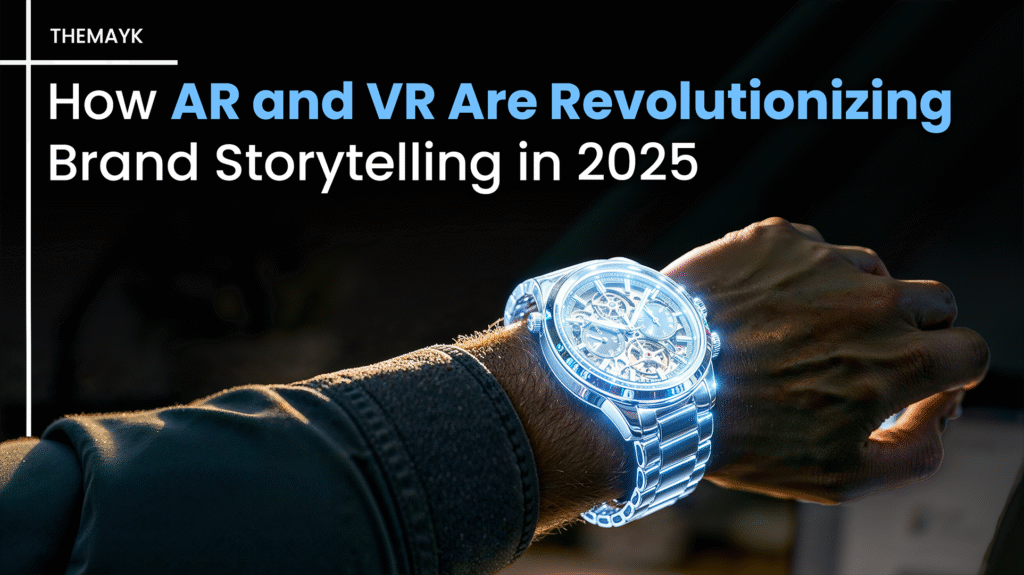How AR and VR Are Revolutionizing Brand Storytelling in 2025
How AR and VR Are Revolutionizing Brand Storytelling in 2025 By 2025, you’re no longer impressed by flat product shots or one-way videos, and neither are…

By 2025, you’re no longer impressed by flat product shots or one-way videos, and neither are your customers. Static visuals used to be enough, but now you expect more. You want to spin a sneaker around, see how that sofa looks in your space, or try on a watch virtually before you hit “buy.” Immersive storytelling isn’t a bonus anymore, it’s the baseline for conversion.
The problem with traditional visuals is simple: they stall your decision. You don’t just want to look—you want to interact, explore, and feel connected to what you’re buying. That’s what actually pushes you from browsing to purchase.
In testing, interactive 3D and AR/VR experiences can lift conversion rates by 30–40% compared to static media. The hidden win? They also reduce product returns, because customers feel more confident before they buy.
The marketing landscape has outgrown the glossy flatlay. Photography and traditional video, while beautiful, lack interactivity. They show a product, but they don’t let the customer feel it.
Today’s consumers want immersive brand storytelling. They expect:
When brands cling to static visuals, they hit a wall in conversion optimization. The barrier isn’t awareness—it’s confidence. Immersive experiences close that gap.
AR and VR are no longer gimmicks. They’re conversion engines. AR/VR marketing enables deeper storytelling, creating worlds where audiences don’t just watch—they participate.
Key advantages include:
In digital experience design, AR/VR bridges imagination and intent. It transforms the passive scroll into an active decision.
A luxury furniture brand came to us struggling with abandoned carts. Beautiful photography wasn’t enough to help customers visualize pieces in their homes.
We built a virtual showroom with hyper-realistic 3D product visualization, integrated directly into their e-commerce flow. Shoppers could walk through spaces, mix and match items, and drop pieces into their own rooms with AR.
*This wasn’t just a design upgrade, it was conversion optimization engineered through immersive storytelling.
Outdated thinking. With modular workflows and scalable tech, production costs are now on par with traditional video campaigns. THEMAYK builds assets that can be repurposed across web, social, and retail platforms.
Wrong. 3D assets plug into Shopify, WooCommerce, Meta AR ads, and even programmatic campaigns. Integration is seamless when executed with the right digital experience design strategy.
The gimmick problem only exists when brands treat AR/VR as novelty. When done right—virtual try-ons, spatial storytelling, product demos—immersive content removes friction and drives action.
For brands ready to level up, here’s the insider roadmap:
Start with high-impact SKUs—products where buyers hesitate without physical experience.
Integrate demos, AR try-ons, or virtual walkthroughs within your funnel. Make them part of the conversion path, not side features.
Repurpose 3D assets into Instagram AR filters, TikTok effects, and Google Swirl ads for maximum reach.
Track dwell time, interaction rates, and funnel drop-offs. Iterate quickly, immersive campaigns thrive on continuous refinement.
This is how conversion optimization in 2025 is achieved: blending storytelling with technology in a way that feels seamless to the customer.
A beauty brand approached THEMAYK with a clear problem: their audience loved browsing, but purchase hesitation killed their funnel.
We launched hyper-realistic 3D product demos with AR try-ons integrated into their website and Snapchat filters. Customers could test shades, finishes, and styles instantly.
*Cross-channel deployment made the experience consistent, social discovery tied directly into e-commerce checkout.
Flat content is yesterday’s internet. Today, you expect experiences that are immersive, interactive, and emotionally connected. If your brand isn’t giving you that, you move on—and so do your customers. The future isn’t just about telling better stories, it’s about solving the conversion gaps that flat visuals can’t.
That’s why at THEMAYK, we don’t just hand you “nice visuals.” We engineer digital experiences that pull people in, turn browsers into buyers, and transform buyers into loyal advocates who stick with your brand.
If you’re serious about scaling your storytelling through 3D product visualization or AR/VR, it’s time to rethink your funnel. And it’s time to let THEMAYK build an experience that actually converts for you.
3D Product Visualization: Hyper-realistic assets that inspire purchase confidence.
AR/VR Marketing: Immersive experiences that increase engagement and reduce hesitation.
Conversion Optimization: Interactive funnels engineered for measurable ROI.
How AR and VR Are Revolutionizing Brand Storytelling in 2025 By 2025, you’re no longer impressed by flat product shots or one-way videos, and neither are…